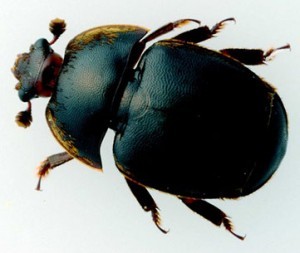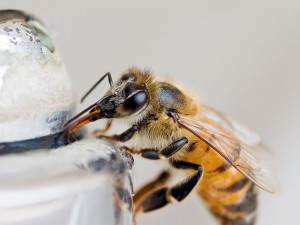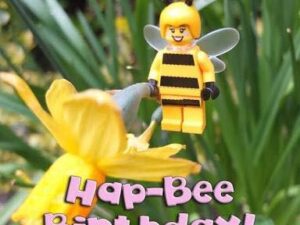
*Check our products page for new equipment to fight small Hive beetle*
Small Hive Beetle
The Small Hive Beetle (Aethina tumida) was first discovered in Australia in 2002, and is now common in the Eastern States. Originally from South Africa they spread to Florida in the USA in 1998 where they caused major damage to the Apiary industry. The climate in Eastern Australia is similar to Florida, hence we have experienced similar damage by this pest.How to recognize them:
The Adult Small Hive Beetle is aprox 6mm long and 3mm wide and vary from dark brown to almost black. Their larvae are white and grow to about 10 mm in length.
Life Cycle:
The adult beetle find the hive by smell – both of the honey/pollen and the pheromones.
Once in the hive, the female can lay up to 500 eggs. These are laid in irregular clusters in the comb or in crevices. The egg is aprox half the size of a honey bee egg. When they hatch into larvae (similar to maggots) they burrow through the wax eating honey and pollen, and defecating in the cells (which causes fermentation) which leaves a heavy slime.
When the grubs are mature they burrow into the soil underneath the hive to pupate.
Control:
To date we have not yet found any method to eliminate this pest. Research continues.
1. Keeping the hive compact and strong appears the best defense.
2. The RRIDC has released a paper suggesting “Best Management Practices” – quoted below.
3. Various traps are in use including :
Plastic beetle trap that sits between the frames.
Various bottom board traps.
Mats placed on top of frames. (The hooks on the beetle legs get snared by the mats).
4. Spraying the ground beneath the hive to kill the larvae.
At the time of writing, the trap on the bottom board has received very favourable reports from commercial bee keepers. These consist of 3.6mm wide slots in the bottom board (or a section of the bottom board is cut out and replaced with a piece of metal/laminex with slots). This is located near the entrance, running the width of the hive, to trap the beetle as it comes in.
A plastic or metal tray is slid underneath, with a mix of vegetable oil and vinegar which acts both as an attractant, and kills the beetle.
Some basic facts: (From the Australian Govt RIRDC paper 🙂
1. Small Hive Beetles are very good flyers (up to 15 Klms).
2. They have very well-developed pheromone receptors.
3. They can live outside the hive on pollen or rotting fruit.
4. They can reproduce on rotting fruit.
5. One female can lay 300-500 eggs a day for 30-60 days.
6. Beetles attract beetles.
7. They prefer hives in the shade to hives in full sun.
8. They are attracted to the stress pheromones of a hive.
9 They use a hive like a hotel – food, warmth, and shelter.
10. Nurse bees will feed the SHB in the cells just like they feed a bee.
11. European bees don’t harass the SHB as much as Africanized bees do.
12. They can overwinter in a hive at –40ºC.
13. A strong hive will keep them in check most of the time.
14. To reproduce in spring or summer, they will go to a weak hive.
15. In autumn, they go to strong hives to keep warm.
16. When the SHB eggs hatch and the larvae slime the hive, the bees will abscond.
17. SHB can’t survive cold temperatures outside the hive.
Best Management Practice:
1. Keep all hives strong. Don’t try to keep weak hives going.
2. Make sure hives are in full sun.
3. Don’t leave deadouts in the bee yard.
4. Check yards every two weeks.
5. If a hive dies out , treat the ground around that hive (1metre square).
6. Don’t keep permanent bee yards. Move hives every 2-3 months.
7. If you have a lot of SHB in an apiary yard, move it.
8. Do not make splits in a heavily infested yard.
9. Do not pull honey from a heavily infested yard.
10. Don’t store a lot of empty supers on hives.
11. Do not allow bees to start robbing in a yard.
12. Keep bottom boards clean. Remove burr comb, brace comb and debris, since they are hiding places for SHB.
13. Screened bottoms help to keep SHB off the bottom boards, but they make the SHB go up in the hive.
14. Remove the hive lid and place it upside down on the ground. Place supers on the lid. Work the brood box and return the supers to the hive. The sun will have driven (most) of the SHB down into the lid. Kill them with your hive tool or tap the lid over a bucket of soapy water. The beetles that fall in the soapy water should die.
15. Keep your hives from being stressed. Stressed hives attract beetles. This means you will also become stressed.




